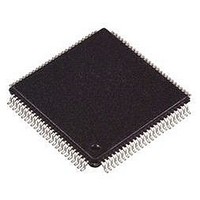MC908GR32ACFAER Freescale Semiconductor, MC908GR32ACFAER Datasheet - Page 251

MC908GR32ACFAER
Manufacturer Part Number
MC908GR32ACFAER
Description
IC MCU 32K FLASH 8MHZ 48-LQFP
Manufacturer
Freescale Semiconductor
Series
HC08r
Datasheet
1.MC908GR32ACFJE.pdf
(314 pages)
Specifications of MC908GR32ACFAER
Core Processor
HC08
Core Size
8-Bit
Speed
8MHz
Connectivity
SCI, SPI
Peripherals
LVD, POR, PWM
Number Of I /o
37
Program Memory Size
32KB (32K x 8)
Program Memory Type
FLASH
Ram Size
1.5K x 8
Voltage - Supply (vcc/vdd)
3 V ~ 5.5 V
Data Converters
A/D 24x10b
Oscillator Type
Internal
Operating Temperature
-40°C ~ 85°C
Package / Case
48-LQFP
Controller Family/series
HC08
No. Of I/o's
37
Ram Memory Size
1.5KB
Cpu Speed
8MHz
No. Of Timers
2
Embedded Interface Type
SCI, SPI
Rohs Compliant
Yes
Processor Series
HC08GR
Core
HC08
Data Bus Width
8 bit
Data Ram Size
1.5 KB
Interface Type
ESCI, SPI
Maximum Clock Frequency
8 MHz
Number Of Programmable I/os
53
Number Of Timers
8
Maximum Operating Temperature
+ 85 C
Mounting Style
SMD/SMT
Development Tools By Supplier
FSICEBASE, DEMO908GZ60E, M68CBL05CE, M68EML08GPGTE
Minimum Operating Temperature
- 40 C
On-chip Adc
10 bit, 24 Channel
Lead Free Status / RoHS Status
Lead free / RoHS Compliant
Eeprom Size
-
Lead Free Status / Rohs Status
Details
Available stocks
Company
Part Number
Manufacturer
Quantity
Price
Company:
Part Number:
MC908GR32ACFAER
Manufacturer:
Freescale Semiconductor
Quantity:
10 000
- Current page: 251 of 314
- Download datasheet (5Mb)
Setting the channel x maximum duty cycle bit (CHxMAX) and setting the TOVx bit generates a 100% duty
cycle output. (See
18.4 Interrupts
The following TIM2 sources can generate interrupt requests:
18.5 Low-Power Modes
The WAIT and STOP instructions put the MCU in low-power standby modes.
18.5.1 Wait Mode
The TIM2 remains active after the execution of a WAIT instruction. In wait mode, the TIM2 registers are
not accessible by the CPU. Any enabled CPU interrupt request from the TIM2 can bring the MCU out of
wait mode.
If TIM2 functions are not required during wait mode, reduce power consumption by stopping the TIM2
before executing the WAIT instruction.
18.5.2 Stop Mode
The TIM2 is inactive after the execution of a STOP instruction. The STOP instruction does not affect
register conditions or the state of the TIM2 counter. TIM2 operation resumes when the MCU exits stop
mode.
18.6 TIM2 During Break Interrupts
A break interrupt stops the TIM2 counter and inhibits input captures.
The system integration module (SIM) controls whether status bits in other modules can be cleared during
the break state. The BCFE bit in the SIM break flag control register (SBFCR) enables software to clear
status bits during the break state. (See
To allow software to clear status bits during a break interrupt, write a 1 to the BCFE bit. If a status bit is
cleared during the break state, it remains cleared when the MCU exits the break state.
To protect status bits during the break state, write a 0 to the BCFE bit. With BCFE at 0 (its default state),
software can read and write I/O registers during the break state without affecting status bits. Some status
bits have a 2-step read/write clearing procedure. If software does the first step on such a bit before the
break, the bit cannot change during the break state as long as BCFE is at 0. After the break, doing the
second step clears the status bit.
Freescale Semiconductor
•
•
TIM2 overflow flag (TOF) — The TOF bit is set when the TIM2 counter reaches the modulo value
programmed in the TIM2 counter modulo registers. The TIM2 overflow interrupt enable bit, TOIE,
enables TIM2 overflow interrupt requests. TOF and TOIE are in the TIM2 status and control
register.
TIM2 channel flags (CH5F:CH0F) — The CHxF bit is set when an input capture or output compare
occurs on channel x. Channel x TIM2 CPU interrupt requests are controlled by the channel x
interrupt enable bit, CHxIE.
MC68HC908GR60A • MC68HC908GR48A • MC68HC908GR32A Data Sheet, Rev. 5
18.8.4 TIM2 Channel Status and Control
14.7.3 Break Flag Control
Registers.)
Register.)
Interrupts
251
Related parts for MC908GR32ACFAER
Image
Part Number
Description
Manufacturer
Datasheet
Request
R
Part Number:
Description:
Manufacturer:
Freescale Semiconductor, Inc
Datasheet:
Part Number:
Description:
Manufacturer:
Freescale Semiconductor, Inc
Datasheet:
Part Number:
Description:
Manufacturer:
Freescale Semiconductor, Inc
Datasheet:
Part Number:
Description:
Manufacturer:
Freescale Semiconductor, Inc
Datasheet:
Part Number:
Description:
Manufacturer:
Freescale Semiconductor, Inc
Datasheet:
Part Number:
Description:
Manufacturer:
Freescale Semiconductor, Inc
Datasheet:
Part Number:
Description:
Manufacturer:
Freescale Semiconductor, Inc
Datasheet:
Part Number:
Description:
Manufacturer:
Freescale Semiconductor, Inc
Datasheet:
Part Number:
Description:
Manufacturer:
Freescale Semiconductor, Inc
Datasheet:
Part Number:
Description:
Manufacturer:
Freescale Semiconductor, Inc
Datasheet:
Part Number:
Description:
Manufacturer:
Freescale Semiconductor, Inc
Datasheet:
Part Number:
Description:
Manufacturer:
Freescale Semiconductor, Inc
Datasheet:
Part Number:
Description:
Manufacturer:
Freescale Semiconductor, Inc
Datasheet:
Part Number:
Description:
Manufacturer:
Freescale Semiconductor, Inc
Datasheet:
Part Number:
Description:
Manufacturer:
Freescale Semiconductor, Inc
Datasheet:











